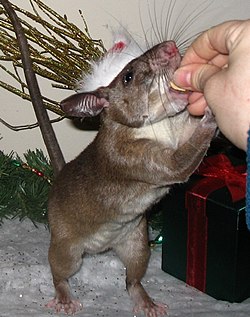
Nesomyidae is a family of mammals in the order Rodentia and part of the Myomorpha suborder. Members of this family are called nesomyids, and include Malagasy rodents, climbing mice, African rock mice, pouched rats, and tufted-tailed rats. They are found in sub-Saharan Africa, primarily in forests, savannas, shrublands, grasslands, and deserts, though some species can be found in rocky areas. They range in size from Monard's African climbing mouse, at 4 cm (2 in) plus a 5 cm (2 in) tail, to the southern giant pouched rat, at 41 cm (16 in) plus a 45 cm (18 in) tail. Nesomyids are generally omnivores, and eat seeds, fruit, nuts, roots, stems, and insects. Few nesomyids have population estimates, but five species—the white-tipped tufted-tailed rat, greater big-footed mouse, western nesomys, eastern voalavo, and Petter's tufted-tailed rat—are categorized as endangered, while the Mount Kahuzi climbing mouse and Malagasy giant rat are categorized as critically endangered.
Contents
- Conventions
- Classification
- Nesomyids
- Subfamily Cricetomyinae
- Subfamily Delanymyinae
- Subfamily Dendromurinae
- Subfamily Mystromyinae
- Subfamily Nesomyinae
- Subfamily Petromyscinae
- References
- Sources
The 67 extant species of Nesomyidae are divided into 21 genera, divided into 6 subfamilies. Cricetomyinae contains 8 species of hamster-rats and pouched rats in 3 genera, Delanymyinae contains a single species, Dendromurinae contains 26 species of climbing mice and fat mice in 6 genera, Mystromyinae contains a single species, Nesomyinae contains 27 species of short-tailed rats, tufted-tailed rats, and big-footed mice in 9 genera, and Petromyscinae contains four species of rock mice in a single genus. Several extinct prehistoric nesomyid species have been discovered, though due to ongoing research and discoveries, the exact number and categorization is not fixed. [1]











































